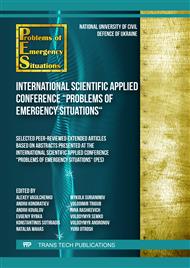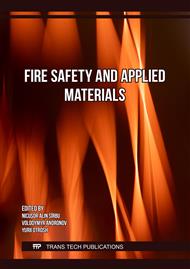[1]
Ivanov E., Loboichenko V., Artemev S., Vasyukov A. Emergency situations with explosions of ammunition: Patterns of occurrence and progress. EasternEuropean Journal of Enterprise Technologies. 1 10 (2016) 26–35.
Google Scholar
[2]
Vambol S., Vambol V., Bogdanov I., Suchikova Y., Rashkevich N. Research of the influence of decomposition of wastes of polymers with nano inclusions on the atmosphere. Eastern-European Journal of Enterprise Technologies. 6 10–90 (2017) 57–64.
DOI: 10.15587/1729-4061.2017.118213
Google Scholar
[3]
Pospelov, B., Rybka, E., Samoilov, M., Morozov, I., Bezuhla, Y., Butenko, T., Mykhailovska, Y., Bondarenko, O., Veretennikova, J. Defining the features of amplitude and phase spectra of dangerous factors of gas medium during the ignition of materials in the premises. Eastern-European Journal of Enterprise Technologies, 2 (10 (116)) (2022) 57–65.
DOI: 10.15587/1729-4061.2022.254500
Google Scholar
[4]
Ragimov, S., Sobyna, V., Vambol, S., Vambol, V., Feshchenko, A., Zakora, A., Strejekurov, E., Shalomov, V. Physical modelling of changes in the energy impact on a worker taking into account high-temperature radiation. Journal of Achievements in Materials and Manufacturing Engineering. 91(1) (2018) 27–33.
DOI: 10.5604/01.3001.0012.9654
Google Scholar
[5]
Dubinin, D., Korytchenko, K., Lisnyak, A., Hrytsyna, I., Trigub, V. Improving the installation for fire extinguishing with finelydispersed water. Eastern-European Journal of Enterprise Technologies, 2 (10-92) (2018) 38-43.
DOI: 10.15587/1729-4061.2018.127865
Google Scholar
[6]
Andronov, V., Pospelov, B., Rybka, E. Development of a method to improve the performance speed of maximal fire detectors. Eastern-European Journal of Enterprise Technologies, 2 (9 (86)) (2017) 32–37.
DOI: 10.15587/1729-4061.2017.96694
Google Scholar
[7]
Pospelov, B., Rybka, E., Togobytska, V., Meleshchenko, R., Danchenko, Yu. Construction of the method for semi-adaptive threshold scaling transformation when computing recurrent plots. Eastern-European Journal of Enterprise Technologies. 4/10 (100) (2019) 22–29..
DOI: 10.15587/1729-4061.2019.176579
Google Scholar
[8]
Semko, A. N., Beskrovnaya, M. V., Vinogradov, S. A., Hritsina, I. N., Yagudina, N. I. The usage of high speed impulse liquid jets for putting out gas blowouts. Journal of Theoretical and Applied Mechanics, 52(3) (2014) 655-664.
Google Scholar
[9]
Melnichenko, A., Kustov, M., Basmanov, O., Karatieieva, O., Shevchuk, N. Devising a procedure to forecast the level of chemical damage to the atmosphereduring active deposition of dangerous gases. Eastern-European Journal of Enterprise Technologiesthis link is disabled. , 1(10-115) (2022) 31–40.
DOI: 10.15587/1729-4061.2022.251675
Google Scholar
[10]
Pospelov, B., Andronov, V., Rybka, E., Popov, V., Romin, A. Experimental study of the fluctuations of gas medium parameters as early signs of fire. Eastern-European Journal of Enterprise Technologies, 1 (10 (91)) (2018) 50–55.
DOI: 10.15587/1729-4061.2018.122419
Google Scholar
[11]
Pospelov, B., Andronov, V., Rybka, E., Krainiukov, O., Maksymenko, N., Meleshchenko, R., Bezuhla, Yu., Hrachova, I., Nesterenko, R., Shumilova, А. Mathematical model of determining a risk to the human health along with the detection of hazardous states of urban atmosphere pollution based on measuring the current concentrations of pollutants. Eastern-European Journal of Enterprise. 4/10 (106) (2020) 37–44.
DOI: 10.15587/1729-4061.2020.210059
Google Scholar
[12]
Popov O., Iatsyshyn A., Kovach V., Artemchuk V., Taraduda D., Sobyna V., Sokolov D., Dement M., Yatsyshyn T. Conceptual approaches for development of informational and analytical expert system for assessing the NPP impact on the environment. Nuclear and Radiation Safety. 2018.
DOI: 10.32918/nrs.2018.3(79).09
Google Scholar
[13]
Semko, A., Rusanova, O., Kazak, O., Beskrovnaya, M., Vinogradov, S., Gricina, I. The use of pulsed high-speed liquid jet for putting out gas blow-out. International Journal of Multiphysics, 9/1 (2015) 9–20.
DOI: 10.1260/1750-9548.9.1.9
Google Scholar
[14]
Tiutiunyk V., Ivanets H., Tolkunov I., Stetsyuk, E. System approach for readiness assessment units of civil defense to actions at emergency situations. Naukovyi Visnyk Natsionalnoho Hirnychoho Universytetu. 1 (2018) 99–105.
DOI: 10.29202/nvngu/2018-1/7
Google Scholar
[15]
Prem, M., Purroy, M. E., Vargas, J.F. Landmines: the Local Effects of Demining. TSE Working Paper. (2022) 22-1305.
DOI: 10.31235/osf.io/3jzk6
Google Scholar
[16]
Dorn, A.W. Eliminating Hidden Killers: How Can Technology Help Humanitarian Demining?. Stability: International Journal of Security and Development. 8(1) (2019) 5.
DOI: 10.5334/sta.743
Google Scholar
[17]
Kulakov, O., Katunin, A., Kustov, M., Slepuzhnikov, E., Rudakov, S. Investigation of Reliability of Emergency Shutdown of Consumers in Electric Power Systems of Explosive Hazardous Zones. 2022 IEEE 3rd KhPI Week on Advanced Technology, KhPI Week 2022 - Conference Proceedings (2022).
DOI: 10.1109/khpiweek57572.2022.9916418
Google Scholar
[18]
Vambol S., Vambol V., Abees Hmood Al-Khalidy K. Experimental study of the effectiveness of water-air suspension to prevent an explosion. Journal of Physics: Conference Series. 1294 7 (2019). 072009.
DOI: 10.1088/1742-6596/1294/7/072009
Google Scholar
[19]
Williams, D. P., Myers, V., Silvious, M.S. Mine Classification With Imbalanced Data. IEEE Geoscience and Remote Sensing Letters. 6(3) (2009) 528-532.
DOI: 10.1109/lgrs.2009.2021964
Google Scholar
[20]
Armstrong, R.W., Elban, W.L. Materials science and technology aspects of energetic (explosive) materials. Materials Science and Technology. Energetic (explosive) materials and deformation at high strain rates. 22(4) (2006) 381-395.
DOI: 10.1179/174328406x84049
Google Scholar
[21]
O. Blyznyuk, A. Vasilchenko, A. Ruban, Y. Bezuhla, Improvement of fire resistance of polymeric materials at their filling with aluminosilicates, Materials Science Forum 1006 (2020) 55-61.
DOI: 10.4028/www.scientific.net/msf.1006.55
Google Scholar
[22]
Palka, N., Szala, M., Czerwinska, E. Characterization of prospective explosive materials using terahertz time-domain spectroscopy. Appl. Opt. 55 (2016) 45754583.
DOI: 10.1364/ao.55.004575
Google Scholar
[23]
Popov O., Iatsyshyn A., Kovach V., Artemchuk V., Taraduda D., Sobyna V., Sokolov D., Dement M., Hurkovskyi V., Nikolaiev K., Yatsyshyn T., Dimitriieva D. Physical features of pollutants spread in the air during the emergency at NPPs. Nuclear and Radiation Safety. 4 84 (2019) 11.
DOI: 10.32918/nrs.2019.4(84).11
Google Scholar
[24]
Danchenko, Y., Andronov, V., Barabash, E., Obigenko, T., Rybka, E., Meleshchenko, R., Romin, A. Research of the intramolecular interactions and structure in epoxyamine composites with dispersed oxides. Eastern-European Journal of Enterprise Technologies. 6 12–90 (2017) 4–12.
DOI: 10.15587/1729-4061.2017.118565
Google Scholar
[25]
I. Ryshchenko, L. Lyashok, A. Vasilchenko, A. Ruban, L. Skatkov, Electrochemical synthesis of crystalline niobium oxide, Materials Science Forum 1038 (2021) 51-60.
DOI: 10.4028/www.scientific.net/msf.1038.51
Google Scholar
[26]
Pospelov, B., Andronov, V., Rybka, E., Meleshchenko, R., Borodych, P. Studying the recurrent diagrams of carbon monoxide concentration at early ignitions in premises. Eastern-European Journal of Enterprise, 3/9 (93) (2018) 34–40.
DOI: 10.15587/1729-4061.2018.133127
Google Scholar
[27]
Otrosh, Yu., Semkiv, O., Rybka, E., Kovalov, A. About need of calculations for the steel framework building in temperature influences conditions. IOP Conference Series: Materials Science and Engineering. 708, (2019) 1.
DOI: 10.1088/1757-899x/708/1/012065
Google Scholar
[28]
Kulakov, O., Katunin, A., Kozhushko, Y., Herasymov, S., Roianov, O., Gorbach, T. Usage of Lidar Systems for Detection of Hazardous Substances in Various Weather Conditions. IEEE Ukrainian Microwave Week, UkrMW 2020 - Proceedings, 9252783 (2020) 360-363.
DOI: 10.1109/ukrmw49653.2020.9252783
Google Scholar
[29]
Shabanova, G.N., Korohodska, A.N., Kustov, M.V., Ivashchenko, M.Y., Taraduda, D.V. Barium-containing cement and concrete for protection against electromagnetic radiation. Functional Materialsthis. 28(2), (2021) 323–326.
Google Scholar
[30]
Kustov, M.V., Kalugin, V.D., Deineka, V.V., Slepuzhnikov, E.D., Deyneka, D.M. Radioprotective cement for long-term storage of nuclear waste. Voprosy Khimii i Khimicheskoi Tekhnologii. 2 (2020) 73–81.
DOI: 10.32434/0321-4095-2020-129-2-73-81
Google Scholar
[31]
Popov O., Iatsyshyn A., Kovach V., Artemchuk V., Taraduda D., Sobyna V., Sokolov D., Dement M., Yatsyshyn T., Matvieieva I. Analysis of possible causes of NPP emergencies to minimize risk of their occurrence. Nuclear and Radiation Safety. 1 81 (2019) 75–80.
DOI: 10.32918/nrs.2019.1(81).13
Google Scholar
[32]
Kaglyak O., Romanov B., Romanova K., Ruban A., Shvedun V. Repeatability of sheet material formation results and interchangeability of processing modes at multi-pass laser formation, Materials Science Forum 1038 (2021) 15-24.
DOI: 10.4028/www.scientific.net/msf.1038.15
Google Scholar
[33]
Teslenko A., Chernukha A., Bezuglov O., Bogatov O., Kunitsa E., Kalyna V., Katunin A., Kobzin V., Minka S. Construction of an algorithm for building regions of questionable decisions for devices containing gases in a linear multidimensional space of hazardous factors. Eastern-European Journal of Enterprise Technologies. 5 10–10 (2019) 42–49.
DOI: 10.15587/1729-4061.2019.181668
Google Scholar
[34]
Janssen, T.J. Explosive materials: Classification, composition and properties. Nova Science Publishers, Inc. (2011) 292.
Google Scholar
[35]
Chatterjee, S., Deb, U., Datta, S., Walther, C., Gupta, D.K. Common explosives (TNT, RDX, HMX) and their fate in the environment: Emphasizing bioremediation. Chemosphere. 184, (2017) 438-451.
DOI: 10.1016/j.chemosphere.2017.06.008
Google Scholar
[36]
Zhou, Sh., Gao, J., Luo, Zh., Hu, Sh., Wang L., Wang T. Role of ferromagnetic metal velvet and DC magnetic field on the explosion of a C3H8/air mixture-effect on reaction mechanism. Energy. 239 (C) (2022) 122218.
DOI: 10.1016/j.energy.2021.122218
Google Scholar



